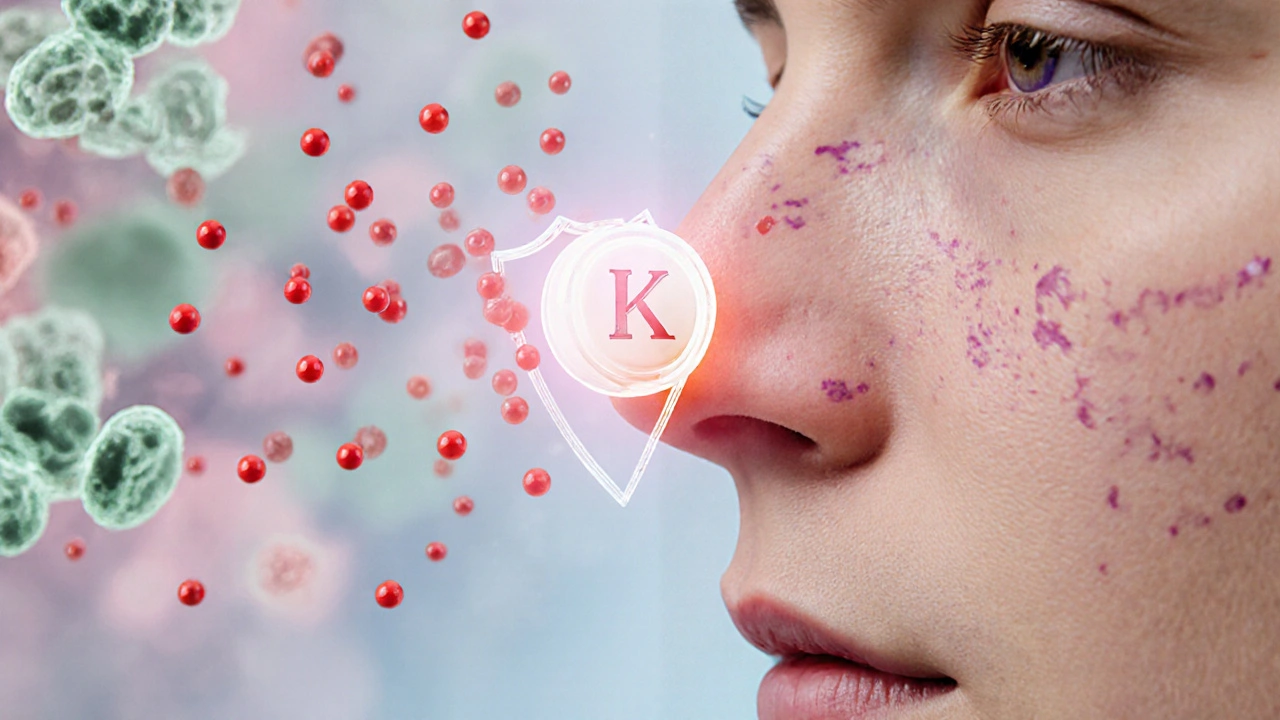Allergy sufferers are constantly hunting for the drug that actually stops the itch, the sneeze, and the watery eyes without leaving them drowsy all day. Ketotifen is a mast cell stabilizer and antihistamine sold under the brand name Ketasma. It works by preventing the release of histamine from mast cells and by blocking H1 receptors, giving a double‑layer of protection. But is it the best choice for you, or do cheaper over‑the‑counter options work just as well? Below we compare ketotifen with the most common alternatives, break down when each shines, and give a quick decision guide.
How Ketotifen Works
Ketotifen belongs to the mast cell stabilizer class. When an allergen contacts the nose or skin, mast cells degranulate and dump histamine, leukotrienes, and other mediators that cause swelling, itching, and mucus. Ketotifen locks the mast cell’s membrane, stopping this cascade before it starts. At the same time, its antihistamine effect blocks any histamine that does manage to slip out, giving a two‑pronged approach that’s especially useful for chronic allergic rhinitis, asthma, and atopic dermatitis.
Key Benefits of Ketotifen
- Effective for both seasonal and perennial allergies.
- Provides relief for eye itching when used as an eye‑drop formulation.
- Less sedating than first‑generation antihistamines like diphenhydramine.
- Can be used as a preventive nightly dose for asthma triggers.
Common Drawbacks
- Prescription‑only in many countries, including Australia.
- Onset of action can take several days for the mast‑cell effect.
- Mild side effects: dry mouth, weight gain, occasional drowsiness.
- Not suitable for patients with severe hepatic impairment without dose adjustment.
Alternatives at a Glance
Here’s a snapshot of the most popular over‑the‑counter (OTC) and prescription options that people typically weigh against ketotifen.
| Drug | Class | Prescription? | Typical Onset | Key Side Effects |
|---|---|---|---|---|
| Ketotifen | Mast cell stabilizer + H1 blocker | Yes | 2‑4 days (preventive) | Dry mouth, mild drowsiness |
| Cetirizine | Second‑generation antihistamine | No | 30‑60 min | Occasional fatigue |
| Loratadine | Second‑generation antihistamine | No | 1‑2 hrs | Rare headache |
| Fexofenadine | Second‑generation antihistamine | No | 1‑2 hrs | Upset stomach (high dose) |
| Cromolyn Sodium | Mast cell stabilizer (spray/ inhaler) | No | 4‑6 hrs (pre‑exposure) | Throat irritation, cough |
| Montelukast | Leukotriene receptor antagonist | Yes | 24‑48 hrs | Mood changes, rare liver enzymes rise |
Antihistamine‑Only Options
Second‑generation antihistamines such as Cetirizine, Loratadine, and Fexofenadine are the go‑to OTC choices for quick relief. They block the H1 receptor but do nothing to stop mast cells from releasing mediators in the first place. That’s why they work great for occasional hay fever but may fall short for chronic asthma or eczema where the inflammatory cascade repeats daily.
Mast‑Cell Stabilizers Beyond Ketotifen
Cromolyn Sodium is the classic inhaled or nasal spray counterpart. It’s purely a stabilizer, so you won’t feel the immediate “blocked histamine” buzz that antihistamines give. It’s ideal for people who can plan ahead-say, before a known pollen peak. Montelukast works downstream by blocking leukotrienes, another set of inflammatory chemicals. Doctors often pair it with inhaled steroids for asthma, but it’s also prescribed for allergic rhinitis when antihistamines and sprays don’t cut it.
When Ketotifen Shines
- Chronic, multi‑system allergies: If you have both nasal and skin symptoms that flare year‑round, the dual action of ketotifen often outperforms a single antihistamine.
- Preventive asthma control: Nightly dosing curbs mast‑cell degranulation, reducing nocturnal asthma attacks.
- Eye allergy relief: The ophthalmic drops (Ketotifen eye drops) target itching without the stinging you get from artificial tears mixed with antihistamines.
Practical Dosing and Tips
- Adults: 1mg orally once daily at bedtime; some clinicians split the dose (0.5mg twice daily) for better tolerance.
- Children 6‑12years: 0.5mg at bedtime, increase to 1mg if needed under doctor supervision.
- Eye drops: one drop in each affected eye twice daily; avoid touching the tip to the eye.
- Take with food if you experience stomach upset.
- Do not combine with other sedating antihistamines; the additive drowsiness can impair driving.
Safety Profile and Contra‑indications
Ketotifen is metabolised in the liver via CYP3A4. Patients on strong CYP3A4 inhibitors (e.g., ketoconazole) may need dose adjustments. It’s contraindicated in severe hepatic failure and should be used cautiously in pregnant women-animal studies show no major teratogenic risk, but human data are limited.

Cost and Accessibility in 2025
In Australia, a 30‑day supply of oral ketotifen costs roughly AUD45-55 under the PBS (Pharmaceutical Benefits Scheme) when prescribed. OTC antihistamines range from AUD12-20 per month, making them the budget‑friendly pick for occasional flares. However, the long‑term savings from fewer asthma attacks and doctor visits often offset the prescription price.
Quick Decision Guide
- Only occasional sneezing or itching? Start with an OTC second‑generation antihistamine.
- Persistent eczema or allergic rhinitis despite antihistamines? Ask your GP about ketotifen or cromolyn nasal spray.
- Asthma that spikes at night? A nightly dose of ketotifen can add a preventive layer.
- Concerned about drowsiness? Second‑generation antihistamines and ketotifen both have low sedation risk, but keep an eye on personal tolerance.
Bottom Line
If you need a single drug that both blocks histamine and stops it from being released, ketotifen offers a unique edge over classic antihistamines. It’s not the cheapest option, and you’ll need a prescription, but for chronic multi‑system allergy sufferers the added stability often translates into fewer flare‑ups and better overall control.
Frequently Asked Questions
Can I use ketotifen for pet allergies?
Yes, ketotifen works on the same mast‑cell pathways triggered by pet dander. Many allergists prescribe it when topical or nasal antihistamines fail to control symptoms from cats or dogs.
How long does it take for ketotifen eye drops to relieve itching?
Most patients notice relief within 15‑30 minutes, with full effect after a few doses. The drops also reduce conjunctival redness.
Is ketotifen safe for children under six?
Safety data are limited for children younger than six. Doctors usually reserve it for older kids or recommend cromolyn spray instead.
Can I take ketotifen with a leukotriene blocker like montelukast?
There’s no direct drug‑drug interaction, and some asthma patients benefit from the combined approach-ketotifen stabilizes mast cells while montelukast blocks leukotrienes.
What should I do if I miss a dose?
Take the missed dose as soon as you remember, unless it’s close to the next scheduled dose. In that case, skip the missed one and continue with your regular timing to avoid double‑dosing.


Nick Rogers on 12 October 2025, AT 15:45 PM
Ketotifen offers a dual mechanism of action; it stabilises mast cells while concurrently antagonising H1 receptors, thereby providing comprehensive allergy control; this distinguishes it from single‑target antihistamines.